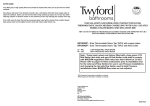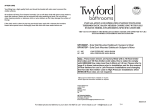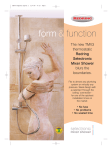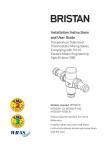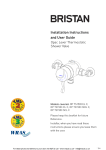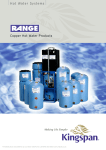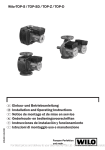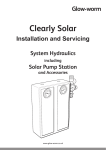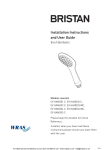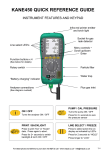Download INSTALLATION AND OPERATING INSTRUCTIONS FOR
Transcript
AFTER CARE Your fitting has a high quality finish and should be treated with extra care to prevent the visible surfaces. All surfaces will wear if not cleaned correctly. Use a soft damp cloth with clean soapy water to clean the surfaces. Stains can be removed with using washing up liquid. Do not use any other cleaning solution or abrasive cloths or wire cleaners as this may damage the surface of the tap. If the cloth used to clean the tap has previously been used with a cleaner that contains bleach take special care to thoroughly rinse the cloth with clean water before use. INSTALLATION AND OPERATING INSTRUCTIONS FOR THERMOSTATIC BASIN MIXERS COMPLYING WITH N.H.S ESTATES MODEL ENGINEERING SPECIFICATION D08 THE VALVE COVERED IN THIS BOOKLET HAS BEEN TESTED AND APPROVED TO N.H.S ESTATES MODEL ENGINEERING SPECIFICATION D08 SF1053CP - Sola Thermostatic Mono Tap TMV3 with copper pipes SF1054CP - Sola Thermostatic Mono Tap TMV3 with flexi hoses LP - WE HP - WE LOW PRESSURE WASH BASIN HIGH PRESSURE WASH BASIN Note : These basin mixers are factory fitted with a lime green 2.75l flow limiter (hot side) and grey 6l flow limiter (cold side) to comply with BREEAM regulations (flow rates less than 6.0l/min at 3.0 bar). Please refer to page 6 in these instructions prior to installation and for the removal of flow limiters for use in Low Pressure installations and changing the Hot side flow limiter used in High Pressure installations when BREEAM flow rates are not required. TMV3 approval information available on request WRAS approval information available on request Twyford Bathrooms Lawton Road Alsager Stoke-on-Trent ST7 2DF UK UK Technical Helpline Telephone: 0844 412 5951 Fax: 0844 412 5922 Email: [email protected] 800442A For latest prices and delivery to your door visit MyTub Ltd - www.mytub.co.uk - [email protected] INTRODUCTION NOTES: It has been recognised that users of hot water in care establishments are at risk from scalding. This risk has been reduced by the use of thermostatic mixing valves. In order to assure the performance of thermostatic mixing valves N.H.S. Estates Model Engineering Specification DO8 was written. The valves listed in the following pages have been tested and approved to this standard by a third party as part of the BUILDCERT scheme for use within their designated applications. The following abbreviated designation codes are used throughout this booklet. Detailed descriptions are given below:HP LP S B W T44 T46 High pressure Low pressure Shower Bidet Washbasin Bath with fill temperature of 44°C max Bath with fill temperature of 46°C max THE SF1053CP & SF1054CP BASIN MIXERS HAVE BEEN APPROVED FOR USE IN THE FOLLOWING TMV3 DESIGNATIONS :- CODE LP-WE HP-WE OPERATING PRESSURE APPLICATION LOW PRESSURE BASIN MIXER HIGH PRESSURE BASIN MIXER For full installation instructions and method of temperature adjustment see General Assembly and Servicing Guide. INSTALLATION RECOMMENDATIONS The following general recommendations should be observed. 1) The thermostatic mixing valve should be installed in such a position that maintenance and the commissioning and testing of the TMV can be undertaken. 2) Always flush both supply pipes fully before connecting mixing valve to ensure no pipe debris enters the inlets. Always fit filters provided. 3) All installations must comply with current local Water Company Regulations. CONDITIONS FOR NORMAL USE In order to give compliance with N.H.S. specification DO8 scheme. The tables below list the conditions for normal use, the valves may perform adequately outside these parameters but the TMV3 scheme approval does not apply. If they are required to work with other supply .conditions an engineer must carry out a risk assessment and satisfy themselves that the units are still suitable for use. 1 14 For latest prices and delivery to your door visit MyTub Ltd - www.mytub.co.uk - [email protected] Faultfinder Table 1: Conditions for normal use Fault No or reduced flow and/or fluctuating temperature Maximum outlet temperature too hot Maximum outlet temperature too cold or runs cold after a short time Cause One or both isolating valves not fully open Open both valves fully Flow limiters incorrectly fitted Check information and refit correctly Tap will not shut off or dripping Low Pressure High Pressure 10 10 Flow Pressure, Hot & Cold (bar) 0.2 to 1 1.0 to 5.0 Hot Supply Temperature (°C) 52 to 65 52 to 65 Cold Supply Temperature (°C) 5 to 20 5 to 20 Minimum temperature differential between mixed temperature and either supply 10°C 10°C Maximim Static Pressure Alter system to increase supply pressures Supply pipes blocked Rectify system fault COMMISSIONING Waterways in tap blocked Clear debris or call service department Since the installed supply conditions may differ from those used in testing and setting the valves during final inspection and a valve may have several designations, it is necessary to reset the mix temperature. The following procedure should be used after ensuring:- Supply pressures unequal Check maximum pressure differential, and check if flow limiters correctly fitted Reset temperature see calibration section Reset temperature see calibration section Maximum mixed water temperature incorrectly set Maximum mixed water temperature incorrectly set Flow limiters incorrectly fitted Maximum mixed water temperature incorrectly set Increase water temperature by adjusting storage temperature or power input to the system See section on flow limiters Reset temperature see calibration section Inlet supplies reversed Seal damaged or worn Re pipe supplies Renew seals from spare parts kit Service and descale fitting Scale build up in body No thermostatic fail safe Operating Pressure Range Inlet pressures below specified values Hot water temperature too low Mixed water flow too high Only hot or cold water at outlet Repair Inlet pressure above maximum static pressure rating Inlet temperatures outside specification Reduce pressure possibly by fitting reducing valve Reset boiler or recirculation temperatures Debris trapped in mechanism or mechanism jammed Strip and clean unit or call the service dept Inlet supplies reversed . Re pipe supplies 13 a) The designation of the thermostatic mixing valve matches the intended application (i.e. if a shower is to be supplied at 2 bar then the valve must have a HP-S designation). b) The supply pressures match those for which the valve has been approved, see table1 and valve details. c) The supply temperatures are such that they are within the permitted range (see table1) and comply with guidance information on the prevention of legionnella. Note:- If the supply conditions are not within the parameters for normal use the valve may still be suitable, but individual engineers must carry out their own risk assessment and satisfy themselves that the units are still suitable for use. Adjust the mixed water temperature in accordance with table 2, the method of adjustment is covered in the section Temperature Setting.(See page 9) Table 2: Mixed Water Temperature Application Bidet Shower Washbasin Bath (44°C fill) Bath (46°C fill) Abbreviated Designation -HP-B, BE,-LP-B, BE -HP-S,SE;-LP-S, SE -HP-W,WE: -LP-W, WE -HP-T44; -LP-T44 -HP-T46; -LP-T46 Mixed water temperature °C 38 max 41 max 41 max 44 max 46 max Note 1: For washbasins, washing under running water is assumed. Note 2: Bath fill temperatures of more than 44°C should only be available when the bather is always under the supervision of a competent person (e.g. nurse or care assistant) Note 3: A thermostatic mixing valve having multiple designations (i.e. it is capable of satisfying the requirements of this specification for more than one application) should be re-set on site to suit the designation required. 2 For latest prices and delivery to your door visit MyTub Ltd - www.mytub.co.uk - [email protected] The following set of tests should be carried out. Maintenance a) record the temperature of the hot and cold water supplies. b) record the temperature of the mixed water at the largest draw-off flow rate c) record the temperature of the mixed water at a smaller draw-off flow rate, which shall be measured. d) isolate the cold water supply to the mixing valve and monitor the mixed water temperature. e) record the maximum temperature achieved as a result of (d) and the final temperature. f) record the equipment, thermometer etc. used for the measurements. If there is damage to the cartridge this will require dismantling and relevant parts replacing [to dismantle follow these steps]. IN-SERVICE TESTING The purpose of in-service testing is to regularly monitor the thermal performance of the thermostatic mixing valve. Deterioration in performance can indicate the need for service work to be carried out on the system. Remove the cartridge as per previous stage. 1. Unscrew the half cartridge by placing a thin blade through the slots in the side, if possible hold the head work assembly in a vice or work mate. [Standard right hand thread]. Circlip Head If the authority concerned does not have a planned test and maintenance schedule then the suggestions below should form the basis of a new system. PTFE Washer At intervals of 6 - 8 weeks and 12 - 15 weeks after commissioning:1. Check supply parameters are still within the expected values if not check system for faults. 2. Carry out commissioning procedures a) to c) using the same test equipment, if the mixed water temperature has changed a significant amount (by more than 1K) check to ensure in-line filters are clean, that the check valves are working and all isolating valves are fully open. If no fault can be found check and record the mixed water temperatures and re -adjust mixed water temperature to the values in table 2. Complete the commissioning procedure a) to f) if the mixed water temperature exceeds the values of the maximum recorded temperature by more than 2K the need for service work is indicated (see relevant instruction leaflet.) Depending on the results of these two tests the following should be adopted 2. Remove the circlip from the flow head, and push the flow head assembly through the head. O’ring 3. Remove the PTFE washer from the flow head. You are now able to unscrew the flow head from the shut off head [left hand thread]. Remove o’ring from shut off head. Shut Off Head **O’ring a) If a small change (e.g. 1K to 2K) occurs in one of these tests or there is no significant change (e.g. 1K maximum) then the next in service test should be 24 to 28 weeks after commissioning. b) If small changes occur in both test or a larger change occurs in one test (exceeding 2K) then the next in service test should be carried out 18 to 21 weeks after commissioning. These results can then be used to set a service interval which tests have shown can be used with no more than a small change in mixed water temperature. This method of determining service intervals is used to take into account various in-service conditions (I.e. water condition) that the valve may experience. NOTE: Valves operating outside these conditions cannot be guaranteed by the Scheme to operate as Type 3 valves. O’ring 4. Unscrew the adjusting screw from the shut off head and remove o’ring. **The o’ring located in the bottom of the shut off head is peened and can not be removed. Adjusting Screw Half Cartridge O’ring 5. Check all ‘O’ rings to ensure they are not damaged. Clean all brass parts in mild soap solution such as washing-up liquid. Rinse with clean water. 6. Reassemble in reverse order. 3 Flow Head 12 For latest prices and delivery to your door visit MyTub Ltd - www.mytub.co.uk - [email protected] Maintenance Continued Maintenance may be required on the internal working parts of your thermostatic mixer tap. Spare parts are available from the manufacturer [see front cover for address]. 1. Isolate the supplies via the isolation valves on the end of the inlet tails. 2. Run the tap to remove any excess water from the thermostatic mixer tap. 3. Remove the grub screw from the back of the lever (use the 2mm Allen key provided). 4. Unscrew the cartridge using a 32mm spanner. [Standard right hand thread]. 5. Once the cartridge has been remove from the thermostatic mixer tap pull out the thermostat and piston assembly. IMPORTANT Do not damage any faces of the piston, this will result in failure of the thermostatic mixer tap 6. Remove all ‘O’ rings from the tap body and replace if damaged. Recommended outlet temperatures The BuildCert TMV scheme recommends the following set maximum mixed water outlet temperatures for use in all premises: 44°C for bath fill but see notes below; 41°C for showers; 41°C for washbasins; 38°C for bidets. The mixed water temperatures must never exceed 46°C. The maximum mixed water temperature can be 2°C above the recommended maximum set outlet temperatures. 46°C is the maximum mixed water temperature from the bath tap. The maximum temperature takes account of the allowable temperature tolerances inherent in thermostatic mixing valves and temperature losses in metal baths. It is not a safe bathing temperature for adults or children. The British Burns Association recommends 37 to 37.5°C as a comfortable bathing temperature for children. In premises covered by the Care Standards Act 2000, the maximum mixed water outlet temperature is 43°C. The fitting of isolation valves is required as close as is practicable to the water supply inlets of the thermostatic mixing valve. Cartridge assembly The fitting of strainers is recommended as close as is practicable to the water supply inlets of the thermostatic mixing valve. Commissioning notes for Thermostatic Mixing Valves. The first step in commissioning a thermostatic mixing valve is to check the following: The designation of the thermostatic mixing valve matches the application. Thermostat The supply pressures are within the valves operating range. The supply temperatures are within the valves operating range. Piston assembly Spring Isolating valves (and strainers) are provided. If all these conditions are met, proceed to set the valve outlet temperature as stipulated in the manufacturer installation instructions. The mixed water temperature at the terminal fitting must never exceed 46oC. It is a requirement that all TMV3 approved valves shall be verified against the original set temperature results once a year. When commissioning/testing is due the following performance checks shall be carried out. Measure the mixed water temperature at the outlet. Body Carry out the cold water supply isolation test by isolating the cold water supply to the TMV, o wait for five seconds if water is still flowing check that the temperature is below 46 C. If there is no significant change to the set outlet temperature (±2°C or less change from the original settings) and the fail-safe shut off is functioning, then the valve is working correctly and no further service work is required. 11 4 For latest prices and delivery to your door visit MyTub Ltd - www.mytub.co.uk - [email protected] Maintenance & Removal of Flow Limiters Notes If there is a residual flow during the commissioning or the annual verification (cold water supply isolation test), then this is acceptable providing the temperature of the water seeping o from the valve is no more than 2 C above the designated maximum mixed water outlet temperature setting of the valve. Temperature readings should be taken at the normal flow rate after allowing for the system to stabilise. If the mixer tap has operated correctly for a time, but no longer performs acceptably, it may require servicing / cleaning. The check valves, flow limiters, and filters are all located in the base unit of the tap. [Removal as follows] The sensing part of the thermometer probe must be fully submerged in the water that is to be tested. 1. Isolated the hot & cold supply via the isolation units on the inlet tails. (Run the tap to ensure no water is left in the supply pipes). Any TMV that has been adjusted or serviced must be re-commissioned and re-tested in accordance with the manufacturers' instructions. 2. Unscrew the grub screws located at the back of the tap near the base. (Use the 2.5mm allen key provided). The installation of thermostatic mixing valves must comply with the requirements of the Water Supply (Water Fittings) Regulations 1999. 3. The tap can now be lifted off the base unit. FLOW RATES 4. Pull out the brass containment units and push the check valves, flow limiters and filters out. The flow rates (L/min) for the tap with and without flow limiters are quoted in the table below 5. Wash in clean running water and reassemble in reverse order. Pressure Drop Bar Low Pressure Flow Rate without Limiters High Pressure Flow Rate with limiters (Pink 4l Hot side & Grey 6l cold Side) High Pressure that conforms to BREEAM flow rate for Basin Mixers < 6.0l/min at 3.0 Bar Flow Rate with limiters (Lime Green 2.75l Hot side & Grey 6l cold Side) Supplied Factory Fitted 0.1 0.2 0.4 0.6 0.8 3.5 5.4 6.5 7.5 8.5 1.0 1.5 2.0 3.0 4.0 5.0 Not recommended, use flow regulators as below. Use Low Pressure Setup 7.2 8.1 8.9 9.4 9.8 10.2 Use Low Pressure Setup 4 4.5 5 5 5 5 Mesh filter Use of flow limiters Containment unit This product will be factory fitted with a lime green 2.75 litre & grey 6 litre flow limiters and also supplied with a standard Pink 4 litre flow limiter for low/high pressure installations. The 2.75l flow limiter is fitted to comply with BREEAM flow rates for a basin mixer of no less than 6l/min at 3.0 bar. Flow limiter The lime green 2.75l flow limiter is positioned in the hot side and the Grey 6l flow limiter positioned in the cold side, this is required when a high pressure system is used. Check valve Recommended: Location of grubscrews Recommended Minimum Dynamic Supply Pressure: 0.2 Bar NOTE: For Dynamic supply pressures below 0.5 bar we recommend removal of the flow regulators to allow increased flow. Minimum cold water supply temperature: 5°C Maximum cold water supply temperature: 20°C Maximum hot water supply temperature: 80°C 5 10 For latest prices and delivery to your door visit MyTub Ltd - www.mytub.co.uk - [email protected] Temperature Setting Maximum dynamic pressure: 5.0 bar & Maximum static pressure: 10.0 bar The tap will have been factory setup to deliver a maximum temperature of 41°C. The site conditions and end users preferences will require the maximum temperature to be reset. This can be achieved by the following steps; 1. Turn the tap to the full open position. NOTE: A suitable hot water temperature control device should be installed to reduce temperatures exceeding the above maximum hot water supply temperature. Minimum temperature differential between hot supply and outlet temperature: 10°C (eg. Outlet temperature 41°C - minimum hot supply 51°C) 2. Remove the targa button using a small flat bladed screw driver thus revealing the grub screw. Factory preset temperature: 41°C & Thermostatic control range: 38 - 45°C 3. Now using the 2mm Allen key provided unscrew the grubscrew. Supply System 4. The lever can be removed. 5. When looking down onto the top of the cartridge you will be able to see the adjusting screw with a hexagon centre. Turning this with the 2.5mm allen key (provided) will increase or decrease the Temperature. + Turn the adjusting screw clockwise for cooler temperature. + Turn the adjusting screw anti-clockwise for warmer temperature. Flow Limiter Cold Supply Hot Supply 0.1 to 5.0 bar 0.1 to 5.0 bar (10 to 50 kPa) (0 to 50 kPa) 0.5 to 5 bar 0.5 to 5.0 bar (50 to 500 kPa) (50 to 500 kPa) or Pumped or Pumped Cold Hot No No Grey (6 Litre) Pink (4 Litre) Grey (6 Litre) No Grey (6 Litre) Pink (4 Litre) Comments Maxium Pressure *** loss ratio 10:1 Gravity 0.2 to 5.0 bar (20 to 50 kPa) r me ar W Gravity above 0.5 bar Coo ler (50 kPa) Unvented Mains Pressurised Mains 1.5 to 10 bar (150 to 1000kPa) Instantaneous Grey Pink Gas Water Heater (6 Litre) (4 Litre) ** Instantaneous Grey * Pink Electric Water Heater (6 Litre) (4 Litre) Grey (6 Litre) # Lime Green (2.75 Litre) Instantaneous Grey # Lime Green Gas Water Heater (6 Litre) (2.75 Litre) Gravity above 0.5 bar (50 kPa) Unvented Mains Pressurised * Pink (4 litre) limiter may not be necessary on some gas heaters. ** IMPORTANT It is a requirement of Instantaneous Electric Water Heaters that a stable flow of water passes through a heater. Failure to regulate outgoing water from the heater may result in fluctuating temperature at the tap. *** For example a pressures of incoming supplier i.e. 0.1 (hot side) and 1.0bar (cold side) would give a 10:1 ratio. # This flow limiter is for High pressure installations when reduced flow economy rates are needed in compliance with BREEAM Regulations. 9 6 For latest prices and delivery to your door visit MyTub Ltd - www.mytub.co.uk - [email protected] Dimensions: Installation SF1053CP Installation must be carried out in accordance with the instructions supplied and be installed by a qualified and competent person 57 115 45 130 Installations must comply with all Local and National Water Authority Regulations, and Building/Plumbing Regulations. - Care must be taken during installation to prevent any risk of injury or damage. - The hole in the basin must consist of a diameter of 30mm to 36mm. - The tap needs to be positioned to allow access to the grub screw on the back of the tap. - To eliminate pipe debris entering the valve it is essential that supply pipes are flushed thoroughly before connecting to the inlet tails. FINAL INSTALLATION 1. Ensure the inlets tails are fully tightened into the base unit. 60 155 2. Secure the clamping studs into the base unit of the tap. (M6 threads). 3. Place the ‘O’ seal over the inlet tails and into the groove located onto the bottom of the tap. 4. Place the base unit seal over the inlet tails and secure on to the bottom of the base unit. 15 5. Place the flexible hoses/copper pipes through the sink hole and clamp the tap to the sink, connect up to the 15mm inlet pipes. (15mm compression fixing). 6. Secure the tap in place with the rest of the clamping kit as per diagram. SF1054CP 57 115 Tap body O’ring groove 45 130 Base unit O’ring M6 Clamping stud 2 off Flexible Hoses or Copper Tubes Clamping ring Base unit seal Clamping stud nut M6 2 off NOTE: This seal sits on underside of basin. 155 7/16” across flats hexagon 15 7 8 For latest prices and delivery to your door visit MyTub Ltd - www.mytub.co.uk - [email protected]








